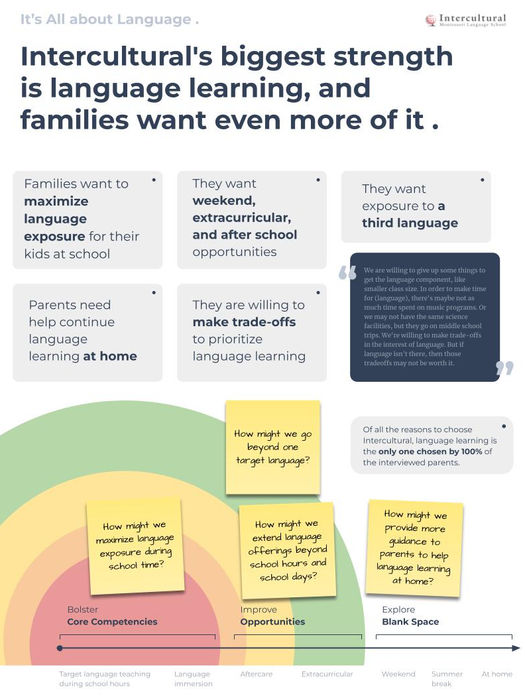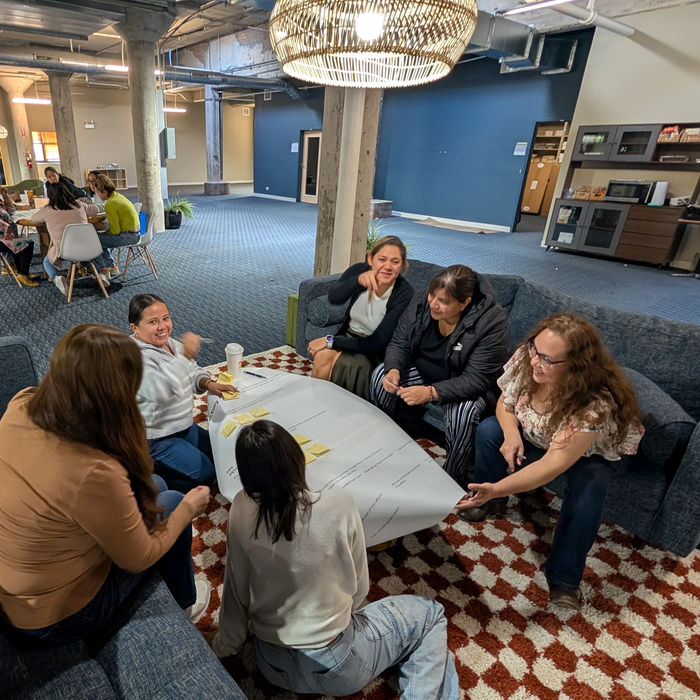Understanding how parents think
We helped a school in Chicago create strategies to boost student retention. After parent interviews, we crafted five actionable insights and four family mindsets. We ran a series of all-staff (50+ people) workshops to socialize the findings and brainstorm ideas. The work engaged and rallied the staff, and was presented to the board of directors. We continue to be involved with the school pushing implementation of the ideas.
Client
Intercultural Montessori Language School
Date
August 2024
Services
Research + strategy
Duration
2 months
Tags
Context
One strategic goal aligned with the school board for 2024 is to identify strategies to address attrition, and improve retention. When reviewing data from admission, we identified that K and 1st are the two key grade levels where attrition happens. We proposed a scope of work that starts with research, and lets strategic insights drive ideation, and culminates with a hands-on workshop to engage, energize, and mobilize staff.
Goals
Our client organization is new to the human centered design approach, but they have a very open-minded leadership team and eager and collaborative staff. We wanted to use parent quotes to bring empathy into the building, uncover a few fresh insights to give them new perspectives, put some tangible ideas on the table that move the needle of retention. Perhaps more importantly and secretly, we want to empower the staff to step up, feel ownership, and take charge. We want to break down departmental silos and start a new normal. We hope small teams of staff members would continue to push their own ideas to fruition, and keep working on other quality improvement projects beyond their day to day job responsibilities.
Create Empathy
In depth conversations with parents could help build empathy with staff, management, and the board. The new perspectives will drive positive change in the school.
Generate Fresh Ideas
Deep understanding of why they come, what makes them stay, and why they leave Intercultural can spark “aha” moments that lead to new ideas to attract, engage, and retain families.
Invigorate Staff
Collaboration is not a buzzword. When the whole team becomes part of the ideation process, they are much more motivated and passionate to own the execution and outcome.
Approach
In order to achieve our goals with limited time and resources, we prioritized the "who," the "why," and the "when". We framed the research around understanding who the parents are, why they choose the school in the first place, why they continued to stay, and why some of them have left. Further, we want to understand two levels of journeys every family goes through. One is the overall journey, comparing different school options, going through the admissions process, deciding on one school, adapting into the new school, settling into the new routine, and deciding to leave. There is another cyclical, yearly cycle of going through two semesters, the seasonal breaks, and reenrolling for next year.

With the research framed up, we were confident that patterns will emerge to help us uncover insights. With the insights, we'd design a workshop experience for the staff to innovate around how we can improve retention. Aligned on the approach, we started recruiting parents to talk to.
Process
Talk to parents
We recruited ten families altogether. Due to limited time and resources, and the qualitative nature of the inquiry, we focused on three spectrums to push for a wide range of recruits. We found two families new to the school, and two that have stayed for many years. We found two families that have left the school in the past couple of years. There are two families with an older sibling who left, yet the younger sibling is still with the school. We also found two families who signed up for a new school year immediately when enrollment was open.

We interviewed these ten families over Zoom, and used Dovetail and FigJam to document and organize our learnings. We created our discussion guide on FigJam, used it to facilitate the conversations, and took notes in it as well. We would debrief after each interview in FigJam and started grouping notes into themes. Each interview was recorded, transcribed, and tagged in Dovetail. Common themes started to emerge from from both FigJam and Dovetail. As analysis progresses, we started to sketch out some frameworks in FigJam as well.

Craft insights
We crafted five insights, which told the story of a well-run school with clear strengths and opportunities that could drive student retention. We started by reaffirming that the clear positioning of the school, quality of teachers, great organizational culture, and strong leadership are the foundation. Then we proceeded to point out several opportunities where the school could engage and help families.
Create family mindsets
We came into the process assuming there would be a few personas to help the team build empathy, bring insights to life, and provide tangibility in ideation. However, as we continue to study the journey of families, compare and contrast new against veteran families, we realized that traditional personas would be too static of a tool. Mindsets were much more appropriate. Mindsets are dynamic in nature. It’s less about who they are, more about where they are in the journey and how they evolve.
We uncovered that mindsets evolve into others over time. More importantly, we identified a key window of time, and ways that the school could influence which direction the mindsets evolve. With the insights and the mindsets in place, we are ready to design a workshop experience and put these tools to use.
Design all-staff workshop experience
We got approval to use two hours during the professional development week right before the fall semester starts. It was an incredibly generous amount of time for the entirety of the staff to dedicate in trying something new. However, two hours were also very tight to go over the findings and work in teams to brainstorm. To add to the challenge, there were going to be more than 50 people participating.

We were humbled by the trust given by the leadership team, and were excited to rise up to the challenge. We allocated 30 minutes to present the insights, 40 minutes to work in small teams of five. Even with the tight schedule, we decided to dedicate 30 minutes for each of the teams to share out. Although generating ideas is valuable, our thinking is that inspiring and empowering the staff to take action is even more critical, especially as the first engagement.
Impact
Our workshop was a resounding success. Not only was the staff fully engaged throughout the workshop, they were able to generate over a hundred ideas in a short amount of time, more importantly, their passion to work together and becoming part of the strategic solution was evident. School leadership was delighted with the result, excited to go into the new semester with boosted morale and momentum to build on and implement some of the top ideas.
After the workshop, we took the generated ideas, grouped, combined, and prioritized them into a dozen or so big ideas. Because of the positive momentum from the workshop, we were invited back for a follow up work session again with all staff on institute day midway into the semester. We designed worksheets for the staff to self organize into project teams and take their own ideas forward. By the end of the follow up work session, each project team had a team lead, a regular time and place to meet, and a timeline to pilot their fledgling ideas.

Our triple diamond process of Research, Strategy, and Design was helpful in orienting and navigating the staff in the process. It resonated so well, one of the staff used it as a framework for student projects in the classroom. We will continue to support Intercultural, and guide the teams to push their projects forward.


























